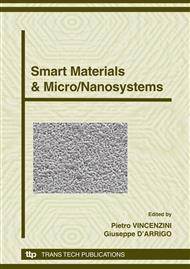p.445
p.451
p.458
p.464
p.470
p.474
p.480
p.486
p.491
Effect of Various Electrode Materials in Non-Volatile Memory Device Using Poly(3,4-Ethylenedioxythiophene):Poly(Styrenesulfonate) (PEDOT:PSS) Thin Films
Abstract:
We have studied the effect of various electrodes on non-volatile polymer memory devices. The ITO/PEDOT:PSS/Top electrode (TE) devices had bipolar switching behavior. The OFF current level of devices increased from 3×10-4 A to 3×10-3 A and the ON voltage decreased from 0.8 V to 0.5 V as the TE work function increased. The yield of devices decreased from over 50 % to under 10 % as the TE work function of devices increased. This result occurred because carrier injection was affected by the TE work function.
Info:
Periodical:
Pages:
470-473
Citation:
Online since:
September 2008
Authors:
Price:
Сopyright:
© 2008 Trans Tech Publications Ltd. All Rights Reserved
Share:
Citation:


